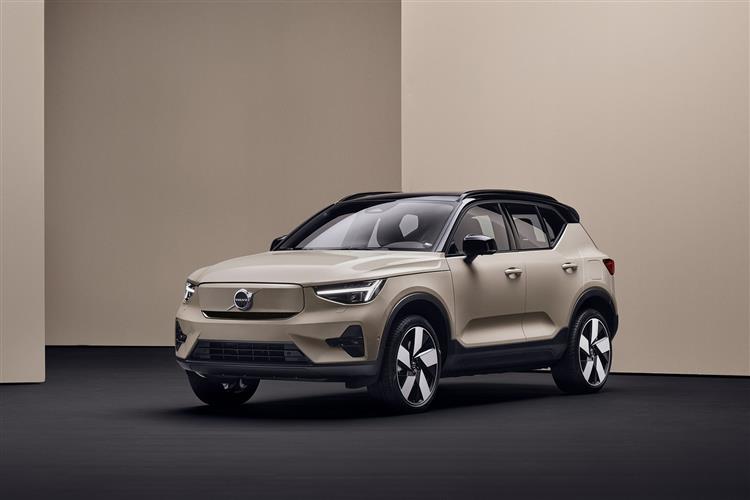How will you view?
This is a sample, and will stop after 30 seconds.
A BATTERY OF QUESTIONS (some text hidden) SECTIONED_new_volvoxc40rechargepureelectric_2021
By Jonathan Crouch
Volvo's first full-EV was this car, what's now called the EX40. Jonathan Crouch takes a detailed look.
Ten Second Reviewword count: 83
The EX40 is pretty much everything you'd expect a Volvo full-EV model to be but in its early XC40 Pure Electric form, needed a few tweaks. It's had them. In recent times with this design, the base single motor front-driven version's been replaced by a rear-driven variant with longer range - and the dual motor AWD model has got a larger battery, so goes further too. The drawback is premium pricing but otherwise, a lot of boxes seem to have been ticked here.
Backgroundword count: 192
You might be surprised that it took so long for Volvo to bring us a full-EV: not until 2020 did it launch its first electric car, the XC40 Pure Electric. Which is strange because the marque was, after all, one of the very first to popularise Plug-in hybrid electrification in its models. Having said that, if you know the industry, you might be surprised that this Gothenburg maker is selling any kind of EV at all. Doesn't Volvo's all-electric subsidiary brand, Polestar, deal exclusively with that? It seems not. Volvo wants (and needs in view of current European directives) to dramatically increase the sales percentage of its electrified models and that can't be done merely by concentrating on mild hybrid and plug-in hybrid engineering. Plus the electric XC40 (renamed the EX40 in early 2024) was designed to sit on the same CMA platform used for the Polestar 2 model, so it was pretty straightforward to create a milkfloat mobility version of this little SUV. The early version wasn't quite cutting edge in terms of battery tech, but more recent updates in 2023 have improved that no end. As we're about to see...
Driving Experienceword count: 470
There are three flavours of EX40 on offer. Most customers will opt for the 69kWh 'Single Motor' version, which was once (in this car's original XC40 Pure Electric form) front-driven, but the Swedish maker's now moved the e-motor to the rear axle and slightly uprated its output to 238hp. Without any real impact on performance - rest to 62mph is dispatched in 7.3s on the way to the 112mph top speed that all Volvos these days share. EV driving range is WLTP-rated at up to 296 miles. To get the claimed mileage, you'll need to engage what the Swedish maker calls 'One Pedal Drive', selectable from the 'Driving' menu provided on this centre-dash screen. This dramatically increases the regenerative braking effect when you come off the throttle, to the point where, as advertised, the brake pedal will hardly ever be needed. There's also a 'Single Motor 'Extended Range' 78kWh mid-level rear-driven model, which has 252hp and uses a larger 78kWh battery providing for a 345 mile range. The faster EX40 alternative is the 'Twin Motor' AWD variant we tried, which uses a larger 82kWh battery pack and twin electric motor set-up that has now adopted different front and rear e-motors, with 150hp and 258hp respectively. These provide for a prodigious 408hp total power output figure in the standard Twin Motor model, but if for some reason that's not enough, you can boost it further to 442hp with an optional 'Performance' software upgrade. Even with a standard Twin Motor EX40 variant, performance is startling, a massive 670Nm of torque (at which point the main motor is spinning at a heady 14,000rpm), catapulting the car to 62mph in just 4.7s. In 'Single Motor' form, an EX40 is around 350kgs heavier than the equivalent XC40 B3 mild hybrid model and you certainly feel that at speed through tight corners. Ride quality though is pleasantly supple and better than most similarly-sized EV rivals, aided by this EV variant's switch to a softer 'Touring' suspension set-up. That doesn't deliver a very sharp feel through the bends, but the distinctly modest level of feedback through the electric steering rack doesn't encourage you to seek that anyway, even if you use the centre screen option that switches the steering to its firmer setting. It's worth noting that the EV figures we mentioned earlier are a little down on those of an identically-engineered Polestar 2. To get the claimed mileage, you'll need to engage what the Swedish maker calls 'One Pedal Drive', selectable from the 'Driving' menu provided on the centre-dash screen. This dramatically increases the regenerative braking effect when you come off the throttle, to the point where, as advertised, the brake pedal will hardly ever be needed. Other than that, no driving modes are provided, though there is a screen button to firm up the steering.
To see the full road test text contact us on 0330 0020 227
Pictures (high res disabled)

.jpg)
|
.jpg)
|
.jpg)
| |||
.jpg)
|
.jpg)
|
.jpg)
| |||

|
Statistics (subset of data only)
Min |
Max |
|
Price: |
£45,955.00 (At 16 Apr 2024) |
£61,855.00 (At 16 Apr 2024) |
Max Speed (mph): |
112 |
|
0-62 mph (s): |
7.3 (Single Motor) |
4.8 (Twin Motor) |
Electric WLTP-Rated Driving Range (miles): |
296 |
|
Length (mm): |
4425 |
|
Width (mm): |
1863 |
|
Height (mm): |
1658 |
|
Boot Capacity (l): |
460 |
|
Power (ps): |
238 (Single Motor) |
408 (Twin Motor) |
Scoring (subset of scores)
Category: Hybrid, Plug-in, Electric & Hydrogen
| Performance | |
| Handling | |
| Comfort | |
| Space | |
| Styling, Build, Value, Equipment, Depreciation, Handling, Insurance and Total scores are available with our full data feed. | |



